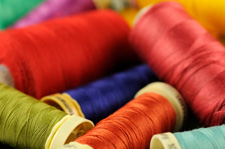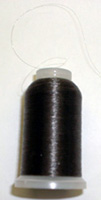Choose The Perfect Sewing Thread For Your Project
When it comes to sewing thread, the selection can become overwhelming unless you know what you are looking for. Choices include cotton, polyester and include a wide variety of different weights and thicknesses.

There are also “special purpose” threads like invisible and metallic. There is a thread out there for every project, and fortunately, with a little experience or research, it can become easy to figure out what thread you will need for whatever you are sewing.
Polyester Thread
The most common thread for almost all sewing projects is polyester. This thread has sheen to it and is strong. It is also available in a nearly endless variety of colors, with one sure to match or contrast whatever color fabric you have. This thread holds fabrics together with a strong bond and is thin and unobtrusive.
All-purpose polythread works for most weights of fabric from lightweight muslins and quilting fabrics to heavy denim and upholstery fabric. It fits most sewing machine and hand needles. Unless you are sewing something specialized, odds are polythread will work for you.
Cotton Thread
The main alternative to polyester thread is 100% cotton thread, which blends in better on matte finished or natural fabrics than polyester. It is not as strong as polyester thread, but will hold fabric together adequately.
People usually use polyester thread on synthetic fabrics and cotton on natural fabrics to make the thread blend in as well as possible. A polyester-cotton blend thread is also available. The polyester in the blend gives extra strength to this thread.
Choosing Your Thread
When you are sewing a project there are two ways to go with sewing thread:
You can color match and make the thread as hard to see as possible. Match the thread color but go one shade darker than your fabric and the thread will blend in much better. If you just can't find the right color and shade, go to a neutral color slightly darker than your fabric but of the same value. You don't want to see your stitches when seams are pressed open.
OR
Use a contrasting color and take your seams from utility to decorative. Of course, if you are going to topstitch you need to make sure you are skilled enough on the sewing machine or with your hand stitching to produce a good-looking stitch. That's easy enough to do with a little practice.
Many people decide to match the color and weight of the thread to their project, and then use another color for decorative purposes. This second layer of thread is usually topstitching thread. It looks thicker and nicer but is not as strong as normal thread. This thread is designed specifically for decorative purposes and is not meant to hold anything together.
For light fabrics such as chiffon and organza, you may wish to go with a lightweight thread such as one labeled for use on silk or “fine” or “lightweight”.
Fabrics such as canvas, duck, and other heavyweight fabrics may need a heavier, thicker thread to hold them together. You can pick a strong polyester all-purpose thread and reinforce your seams or use a thicker thread such as upholstery or buttonhole thread.
What about Speciality Sewing Thread?
“Invisible” sewing thread will work well for most projects of average fabric weight although it has a shine to it and is not the strongest thread.

It should only be used for tasks like hemming and other non-structural seams that will not show.
Metallic and embroidery threads are just for decoration and will not hold a piece together well.
Serger Thread is only for specialized machines called sergers, and you will know if you need it.
If in doubt just go with threads labeled all-purpose or general use and you should be fine.
Related Articles
Go to top of this Sewing Thread pageReturn to CreativeSewingTips.com Home Page




